Introduction
Welcome to our in-depth guide on flooring, where we'll explore the elegant choices between Solid Hardwood Flooring and Engineered Flooring. Selecting the perfect flooring isn't just about picking a style—it's a crucial decision that influences the ambiance, functionality, and value of your living space. Whether you're updating a classic home or completing a new construction, understanding the differences between engineered and hardwood floors is essential.
This guide will cover everything from basic concepts to detailed comparisons of each flooring type. We'll examine aspects such as cost, installation, durability, and style to help you make an informed decision. If you find yourself pondering which flooring option to choose, this article will provide you with the necessary insights to make a decision that enhances your home for many years. Dive into our guide and discover the foundation for a well-informed flooring choice!
What is Solid Hardwood Flooring?
Solid hardwood flooring is made entirely from a single piece of wood, commonly sourced from durable species such as maple or oak. Renowned for its timeless beauty and robustness, this type of flooring enhances any room with a touch of elegance and character. Maple hardwood flooring and red oak hardwood flooring are popular choices, valued for their resilience and the rich ambiance they provide. Solid hardwood has the advantage of being restorable through sanding and refinishing, significantly prolonging its life by refreshing its appearance. Exotic hardwood flooring, another esteemed option, offers unique patterns and grains that can elevate the aesthetic of any space. It is crucial, however, to install hardwood floors in environments with stable humidity and temperature to avoid expansion, contraction, and potential warping or gaps.
What is Engineered Hardwood Flooring?
Engineered flooring combines the classic beauty of hardwood with improved practical features. This type of flooring is constructed with a core layer, usually composed of plywood or high-density fiberboard (HDF), and is topped with a thin layer of hardwood veneer. The multi-layer structure provides enhanced stability, preventing issues such as warping and expansion that often plague traditional hardwood floors. Golden Elite Deco Engineered floors, available in stylish finishes such as Maple Engineered, Red Oak Engineered, White Oak Engineered, and Acacia Engineered, provide the sophisticated look of hardwood. Their robust construction makes them ideal for areas like kitchens and basements, where moisture and temperature can vary.
Now, let's delve into the key differences between Solid Hardwood Flooring and Engineered Flooring with some specific data:
| Feature | Solid Hardwood Flooring | Engineered Flooring |
| Construction | Made entirely of a single piece of solid wood. | Composed of a plywood or HDF core with a real wood veneer layer. |
| Stability | Can warp or change shape with humidity and temperature changes. | More stable, with minimal expansion and contraction. |
| Installation Method | Needs to be nailed to the floor. | Options include nailing, floating (not nailed or glued), or gluing down. |
| Average Cost | Ranges from $4 to $9 per square foot. | Typically, $3 to $10 per square foot, making it a bit cheaper. |
| Refinishing Capability | Can be refinished multiple times throughout its lifespan. | Limited to 1-2 times refinishing, depending on veneer thickness. |
| Suitable Locations | Better for areas without moisture, like living rooms. | Suitable for all levels of a home, including basements. |
| Lifespan | Can last 50 years or more with proper maintenance. | Around 20-30 years with proper care. |
| Aesthetic Variety | Offers the authentic look with varied natural grain patterns. | Wide variety of finishes and wood types available. |
| Environmental Impact | Uses a lot of wood, which can affect forests. | Uses less hardwood, which may be sourced sustainably. |
| Cleaning Recommendations | Avoid wet mops to prevent water damage. | Wet mopping is permissible and generally safe. |
| Sizes Available | Thickness: approx. 3/4 inch | Thickness: 1/2 to 3/4 inch |
Appearance:
Solid Hardwood Flooring
Engineered Hardwood Flooring
When choosing flooring for a home or office, appearance plays a pivotal role. Both solid hardwood flooring and engineered hardwood flooring offer unique visual appeals that can transform any space. However, understanding their differences in aesthetics can help you make an informed decision that aligns with your design vision and practical needs.
Solid Hardwood Flooring
Solid hardwood flooring is often celebrated for its authenticity and traditional charm. Each plank is a slice of natural history, milled from a single piece of hardwood such as oak, maple, or walnut. The natural grain patterns, color variations, and occasional imperfections like knots and mineral streaks, give solid hardwood floors a distinct, irreplaceable character that becomes more pronounced with age.
As solid hardwood ages, it gains a deeper color and richer patina, adding to the floor’s aesthetic value. The depth and texture offered by solid hardwood are unparalleled; it can complement any interior design scheme, from rustic country homes to sleek, modern lofts. Furthermore, the versatility of finishes—from glossy to matte—and the ability to refinish the surface multiple times allows homeowners to rejuvenate the appearance or even change the wood's stain to match evolving decor trends.
Engineered Hardwood Flooring
Engineered hardwood flooring, while maintaining the look and feel of solid hardwood, provides additional versatility and stability. This type of flooring consists of a top layer of real hardwood veneer attached to several layers of plywood or high-density fiberboard. The veneer surface, available in various species and finishes just like solid hardwood, is what is visible and walked upon.
One of the primary aesthetic advantages of engineered hardwood is its consistency. The controlled manufacturing process allows for minimal variation between planks, ensuring a uniform appearance across the floor. This can be particularly advantageous in larger spaces or rooms with open floor plans where consistent color and texture are aesthetically crucial. Moreover, engineered hardwood is available in wider planks because the substrate provides additional stability, which can create a sense of openness and fewer seams in a space.
Engineered hardwood also offers a wide range of modern finishes and can replicate the look of rarer, more expensive woods without the same cost, making luxury more accessible. Its ability to handle higher levels of humidity and temperature fluctuations without warping makes it suitable for use in less traditional areas, such as basements or over concrete slabs, where solid hardwood might not perform as well.

Red Oak Bistro Solid Hardwood Flooring - Tongue & Groove - Nougatine - 3¼"
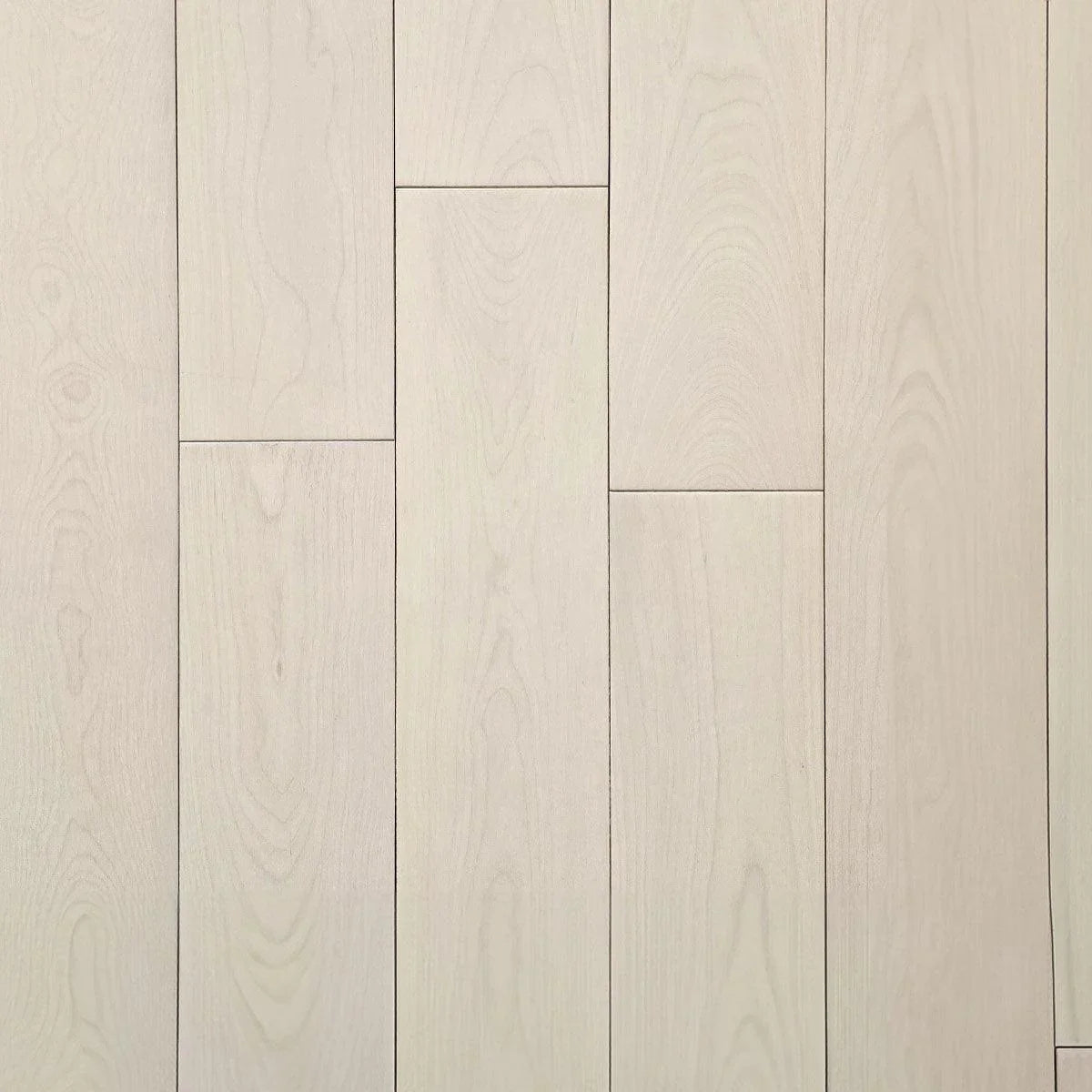
Honey Maple Solid Hardwood Flooring - Whitehaven Beach - 4 3/4"

Honey Maple Solid Hardwood Flooring - Dark Roast - 4 3/4"

Honey Maple Solid Hardwood Flooring - Coffee Bean - 4 3/4"
Cost Analysis:
When planning to upgrade your flooring, understanding the cost implications of your choices is crucial. Here we compare the pricing of solid hardwood and engineered hardwood floors to help guide your decision based on budget considerations.
Cost of Solid Hardwood Flooring
Solid hardwood flooring is often considered a premium choice, known for its luxury and longevity. The cost can vary widely depending on the type of wood selected. More common woods like oak typically start at about $4 per square foot, while more exotic varieties such as Brazilian cherry or mahogany can exceed $15 per square foot. These costs reflect only the materials themselves and do not include any associated installation charges.
Maintaining solid hardwood floors can also contribute to the overall expense. Periodic sanding and refinishing are necessary to preserve their appearance and durability, particularly in high-traffic areas. These maintenance requirements should be considered as part of the total cost of ownership.
Cost of Engineered Hardwood Flooring
Engineered hardwood offers a more economical alternative to solid hardwood, without significantly compromising on appearance. Prices for engineered flooring range from $3 to $10 per square foot, influenced by the thickness of the top veneer and the quality of the core materials used.
Engineered hardwood is also generally less costly in terms of maintenance. Many modern engineered floors are designed with highly durable finishes that seldom require refinishing. However, if refinishing is needed, the frequency and feasibility will depend on the thickness of the top layer of veneer.
Financial Considerations for Your Flooring Choice
While solid hardwood is a more costly investment upfront and in terms of ongoing maintenance, it adds a level of elegance and value to your home that is unmatched. On the other hand, engineered hardwood provides a durable and visually appealing option that is easier on the wallet both at the outset and over its lifetime. Choosing the right type of wood flooring will depend on your immediate budget constraints, long-term financial considerations, and the specific needs of your space.
Lifespan of Flooring:
When choosing hardwood flooring, understanding the longevity and resilience of each type is crucial for homeowners and builders alike. In this section, we'll delve into the lifespan of solid hardwood flooring versus engineered hardwood flooring, elucidating the factors that influence their durability and long-term performance.
Solid Hardwood Flooring
Solid hardwood flooring is often celebrated for its authenticity and timelessness. Made from single pieces of hardwood, typically ranging from 5/8 to 3/4 inches thick, solid hardwood is known for its robustness and ability to withstand years of foot traffic. The lifespan of solid hardwood flooring can be extensive, often stretching over a century with proper care and periodic refinishing.
Key Factors Affecting Lifespan:
- Wood Species Hardness: The longevity of solid hardwood significantly depends on the hardness of the wood species used. For instance, denser woods like oak, maple, and cherry are more resistant to wear and tear, thereby extending the floor's lifespan.
- Environmental Conditions: Solid hardwood floors thrive in stable environments where humidity and temperature levels are controlled. Fluctuations in these conditions can cause the wood to expand and contract, leading to warping or splitting over time.
- Maintenance and Refinishing: One of the most substantial benefits of solid hardwood is its ability to be sanded down and refinished multiple times throughout its life. This not only rejuvenates the appearance of the floor but also extends its serviceability, erasing years of wear.
Engineered Hardwood Flooring
Engineered hardwood flooring, on the other hand, is a modern solution designed to offer the beauty of hardwood with enhanced stability. This flooring type is constructed from multiple layers of plywood or high-density fiberboard, topped with a thin veneer of real hardwood. Engineered hardwood is generally more adaptable to various climates compared to solid hardwood, as its layered construction reduces the wood's natural tendency to shift with changes in humidity.
Key Factors Affecting Lifespan:
- Thickness of Top Layer: The veneer layer of engineered hardwood can vary in thickness, typically between 1mm and 6mm. Thicker top layers allow for occasional refinishing, which can significantly prolong the floor's life.
- Core Material Quality: The durability of engineered hardwood also hinges on the quality of its core layers. High-quality plywood cores offer superior stability and are less prone to warping.
- Installation Method: Unlike solid hardwood, which is typically nailed to a subfloor, engineered hardwood can be installed using floating, glue-down, or nail-down methods. The method of installation can influence the floor's stability and resilience against moisture and movement.
Comparative Longevity
While both types of hardwood flooring offer considerable lifespans, the choice between solid and engineered hardwood often boils down to specific environmental conditions and usage requirements. Solid hardwood is unparalleled in its potential longevity and classic appeal, especially in consistent climates. Engineered hardwood, however, excels in areas with higher moisture levels or where a floating floor setup is needed, providing a practical yet beautiful flooring solution that competently mimics solid hardwood.
Both types of flooring will last for decades when properly maintained, with solid hardwood generally holding the edge in potential lifespan, especially when the opportunity for multiple refinishings is considered. However, engineered hardwood offers a pragmatic alternative with sufficient durability for most modern homes.
By selecting the appropriate type of hardwood flooring and adhering to proper care and maintenance, homeowners can enjoy beautiful and enduring floors that enhance their living spaces for many years to come.

Oak Engineered Hardwood Flooring - Click - Smoked Parchment - 5"
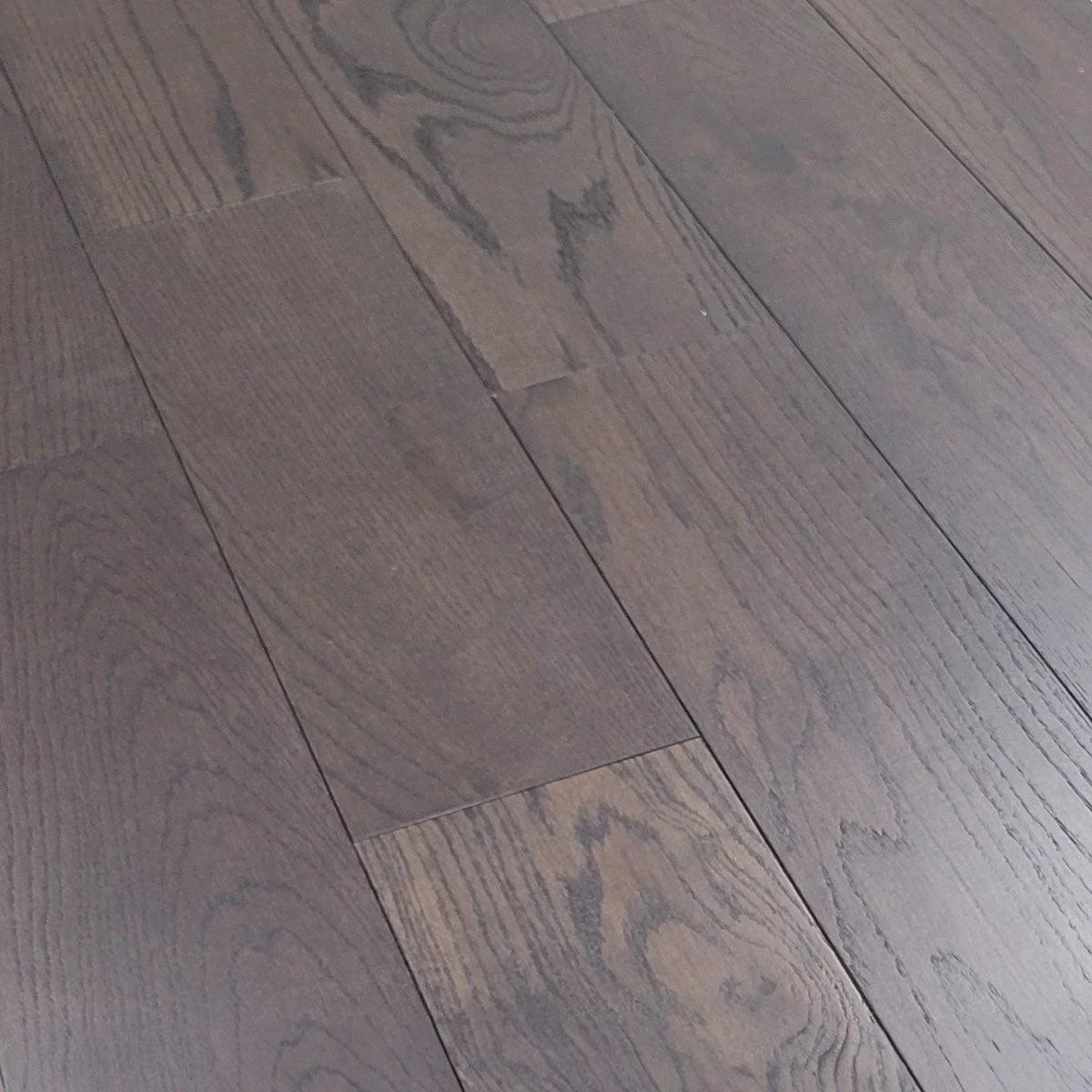
Red Oak Engineered Hardwood Flooring - Tongue & Groove - Belgian Chocolate - 6 1/2" x 3/4"
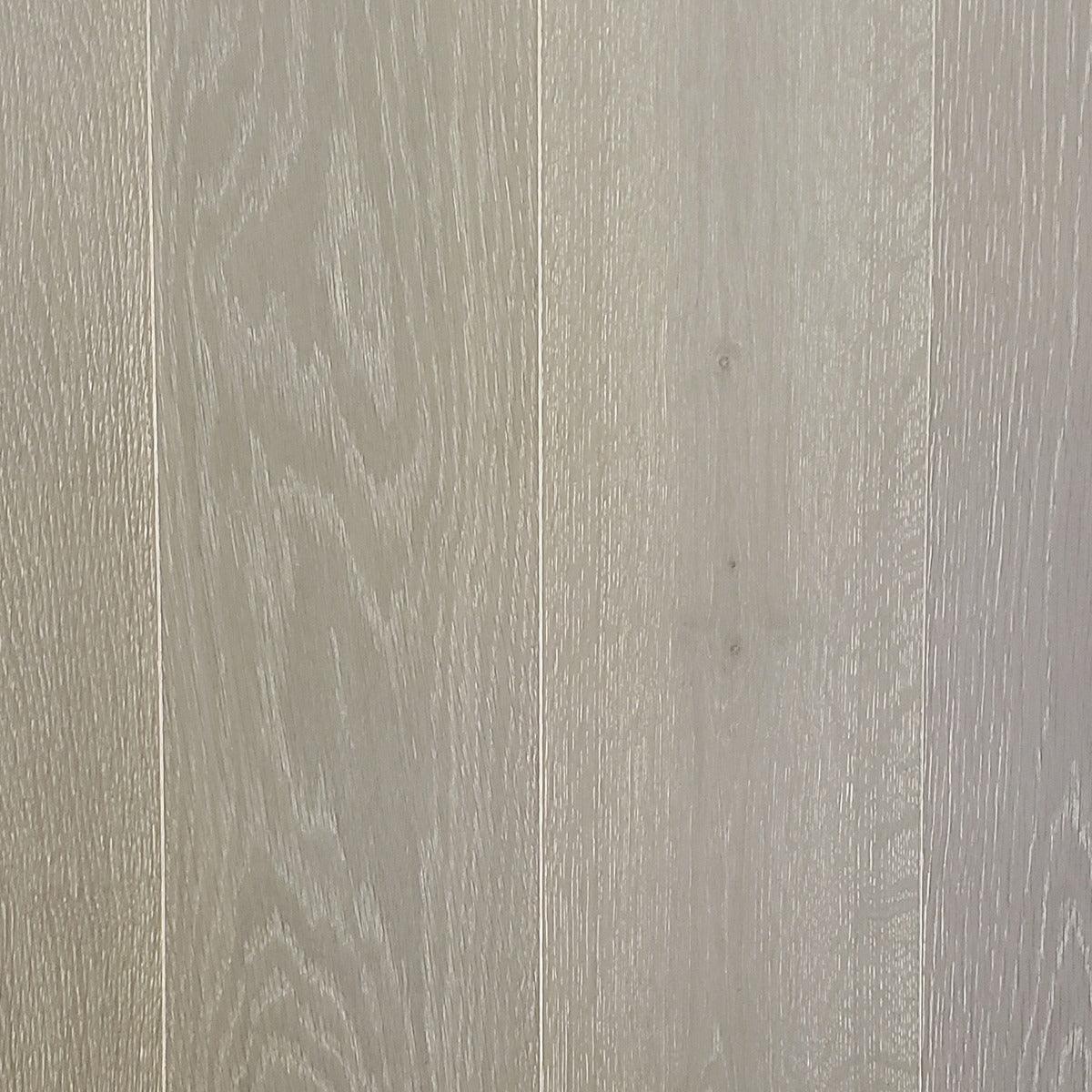
White Oak Engineered Hardwood Flooring - Click - Horizon - 4 1/4"
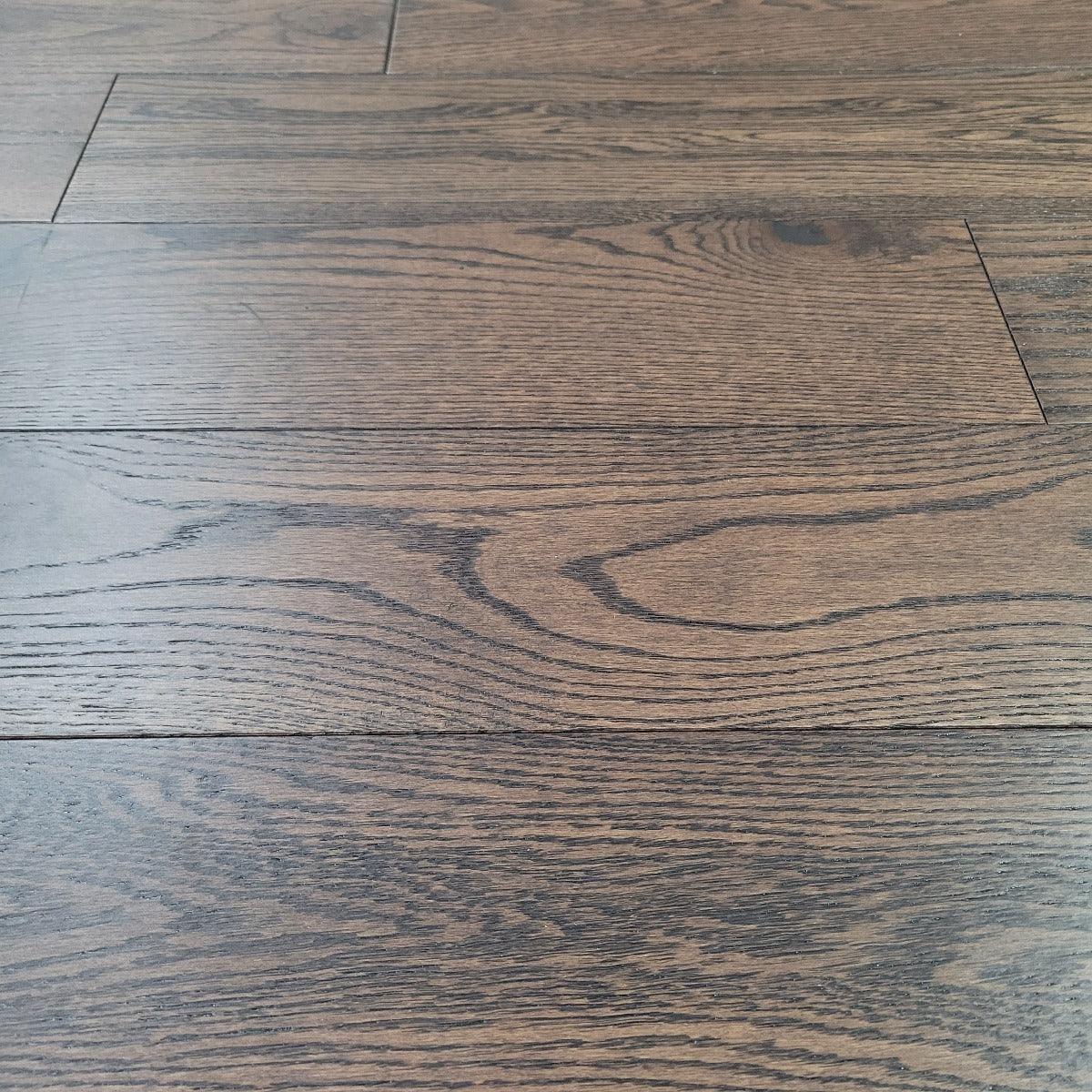
Red Oak Engineered Hardwood Flooring - Tongue & Groove - Tiramisu - 6 1/2" x 3/4"
In-Depth Installation Insights
Solid Hardwood Flooring Installation
Solid hardwood floors exude traditional beauty and are known for their durability. Installation of solid hardwood typically involves a meticulous process where each wood plank is nailed down to a subfloor. This method requires a controlled environment to prevent potential warping of the wood. Solid hardwood must also acclimate to the interior climate of a home before installation, which is crucial for maintaining the wood’s stability over time. Due to the complexity of this process, professional installation is recommended to ensure optimal longevity and performance.
Engineered Hardwood Flooring Installation
Engineered hardwood offers ease and flexibility in installation, making it a practical choice for many homes. It can be installed over different types of subfloors, including concrete and existing floors, using methods like floating, gluing, or stapling. The layered construction of engineered hardwood planks allows them to adapt to varying humidity levels and temperatures, which can be beneficial for below-grade installations like basements or regions with fluctuating climates.
Considerations on Resale Value
Solid Hardwood Flooring Resale Potential
Solid hardwood flooring is highly valued in the real estate market due to its long lifespan and timeless appeal. It can significantly enhance a home’s resale value. The ability of solid hardwood floors to be refinished multiple times allows future homeowners to customize their appearance, which is a highly attractive feature for prospective buyers.
Engineered Hardwood Flooring Resale Potential
Engineered hardwood also contributes to home value improvement, although generally to a lesser extent than solid hardwood. The key factor influencing its resale value is the quality of the materials, especially the thickness of the top hardwood layer, which affects the possibility of refinishing. Floors with a thicker top layer and high-quality construction tend to be more appealing in the real estate market.
Environmental Impact Considerations
Solid Hardwood Flooring and the Environment
The environmental impact of solid hardwood flooring largely depends on the sourcing of the wood. Choosing hardwood from sustainably managed forests helps reduce the ecological footprint. However, solid hardwood requires more raw wood per square foot, which can be a concern for environmentally conscious homeowners.
Engineered Hardwood Flooring and the Environment
Engineered hardwood is often seen as a more sustainable option compared to solid hardwood. It uses less primary hardwood, utilizing lower-quality wood or recycled materials for its base layers. This efficient use of resources reduces the overall environmental impact and supports sustainable forestry practices.
Sound Insulation Features
Acoustics with Solid Hardwood Flooring
Solid hardwood is renowned for its ability to enhance the acoustic quality of spaces, offering depth and richness to the sound within a room. However, this characteristic can also lead to increased noise levels, especially in homes with multiple stories. To mitigate this, proper sound insulation is crucial. High-quality underlayment is an effective strategy to absorb sound, decrease noise transmission from one floor to another, and enhance the overall comfort and quietness of your living environment.
Acoustics with Engineered Hardwood Flooring
Engineered hardwood, thanks to its multi-layer construction, naturally provides better sound dampening properties than solid hardwood. Each layer of the engineered wood is strategically placed to disrupt and absorb sound waves, making it an excellent choice for reducing footfall noise and echoing in spaces. For even more effective sound insulation, incorporating a specialized underlayment can significantly improve the acoustic performance of engineered hardwood floors.
When it comes to enhancing the sound insulation properties of both solid and engineered hardwood floors, Golden Elite Deco offers a variety of underlayment solutions tailored to meet these needs. Their products are designed to complement the natural acoustic properties of hardwood flooring, adding an extra layer of noise protection and moisture resistance, which is particularly beneficial in multi-level buildings or areas with high foot traffic. By choosing the right underlayment from Golden Elite Deco, homeowners can ensure their flooring not only looks stunning but also provides the best possible environment for comfort and tranquility.
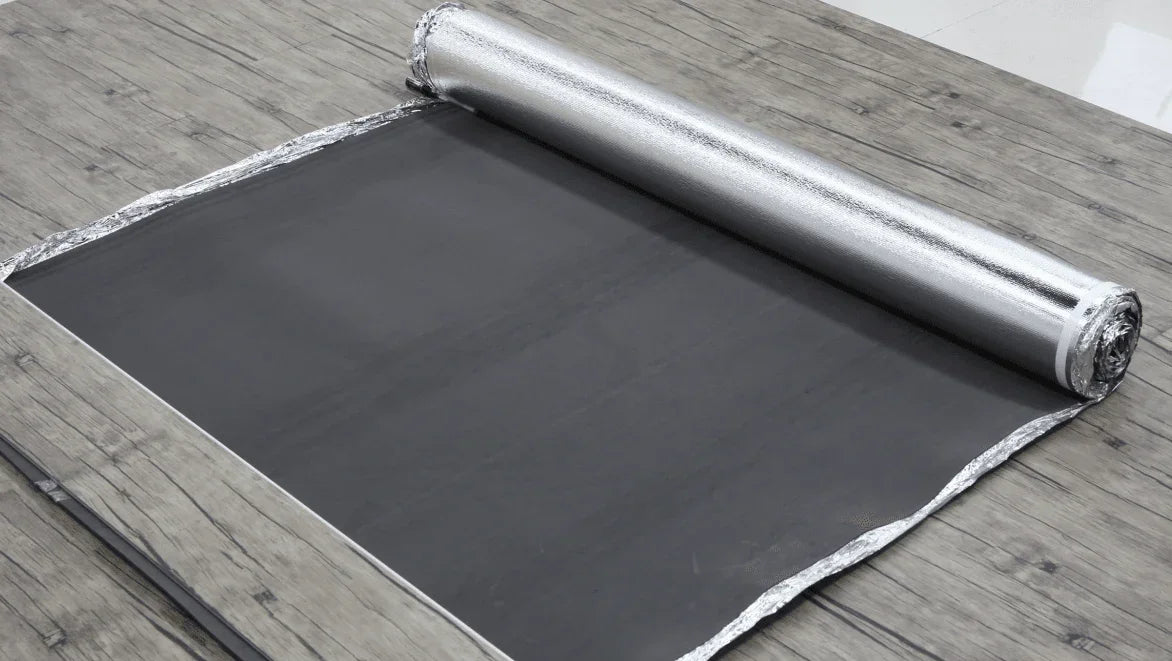
SupexBond Acoustic Underlayment for Laminate & Engineered Flooring

Silver Guard 2 in 1 Underlayment for Laminate & Engineered Flooring

Kodak Wax Paper 400 sqft/roll - Waxed Paper Underlayment for Wood Flooring

SupexNoir Acoustic Underlayment for SPC and Vinyl Clic Flooring
Durability
Solid Hardwood Flooring
Solid hardwood is made from a single piece of wood, typically ¾ inch thick. It's durable and can be refinished several times to erase wear. However, it's sensitive to humidity and temperature changes, which can cause warping or gaps.
Engineered Hardwood Flooring
Engineered hardwood has a top layer of real wood veneer over a base of plywood or fiberboard, making it more stable and less affected by moisture. Its durability depends on the thickness of the top layer; thicker layers can be refinished like solid wood.
Both types are long-lasting. Solid hardwood is ideal for stable, controlled environments, while engineered hardwood is better for areas with moisture. Choose based on your home’s conditions and flooring longevity needs.
Which is Better: Hardwood Flooring or Engineered Hardwood Flooring?
When deciding between solid hardwood flooring and engineered hardwood flooring, consider your home's specific needs. Solid hardwood is renowned for its durability and the ability to be refinished multiple times, making it ideal for areas with stable climate conditions. Engineered hardwood, constructed with a top layer of hardwood veneer and multiple layers of plywood underneath, offers better resistance to moisture and temperature changes, making it suitable for varied climates and lower levels of a home. Ultimately, the choice depends on factors like moisture exposure, budget, and whether the ability to sand and refinish the surface is a priority.
Conclusion
Throughout this guide, we've explored the distinct characteristics and advantages of both solid hardwood and engineered hardwood flooring. Solid hardwood is celebrated for its durability, classic appeal, and the ability to enhance the resale value of your home through its potential for multiple refinishing. On the other hand, engineered hardwood offers superior resistance to moisture and temperature changes, making it a versatile choice for almost any room in your house. The decision between these two types of flooring should be based on your specific environmental conditions, maintenance preferences, and budget.
Next Steps: Planning Your Flooring Project with Golden Elite Deco
- Evaluate Your Needs: Start by considering the specific needs of each room. Whether it’s the high-moisture environment of a kitchen or the high-traffic area of a living room, Golden Elite Deco offers a range of solid and engineered hardwood options to suit various interiors.
- Get an Estimate: Contact Golden Elite Deco to discuss your project and obtain an estimate. Our team of experts can provide insights and pricing to help you make an informed decision based on your budget and requirements.
- Professional Consultation: Take advantage of a professional consultation to navigate through your options more efficiently. Our specialists can guide you through the selection process, ensuring that your choice meets both your aesthetic and functional needs.
- Schedule Installation: Once you have selected your preferred flooring, Golden Elite Deco’s skilled professionals are ready to ensure it is installed correctly. Proper installation is crucial to maximizing the lifespan and appearance of your flooring.
By partnering with Golden Elite Deco, you ensure that your flooring investment is in good hands, from the initial consultation to the final installation. Let us help you transform your space with the perfect flooring that reflects your style and meets your everyday life demands.



